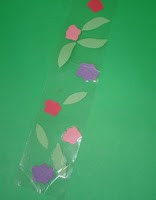Pirate Read
Reread poems and big books by talking out of the side of your mouth like a pirate.
Pirate Song – Tune: “Yankee Doodle”
I’m a pirate. That I be!
I sail my ship upon the sea.
I stay up late – til half past three.
And have a peg below my knee.
Yo ho ho ho
Let’s sail away
Aarrr! Matey! Is what I say.
A treasure I will hide today
And walk the plank another day.
Note! I adapted this song from one posted on talklikeapirateday.com
Creative Writing
Pirate Song – Tune: “Yankee Doodle”
I’m a pirate. That I be!
I sail my ship upon the sea.
I stay up late – til half past three.
And have a peg below my knee.
Yo ho ho ho
Let’s sail away
Aarrr! Matey! Is what I say.
A treasure I will hide today
And walk the plank another day.
Note! I adapted this song from one posted on talklikeapirateday.com
Creative Writing
What would you do if you were a pirate? Where would sail on a pirate ship? What would you like to find in a treasure chest?
Pirate Cheer
Pirate Cheer
Put one hand over your eye to make a patch. Talk out of the side of your mouth as you say, “Aarr! Way to go, matey!”
Parrot Cheer
Parrot Cheer
Put your hands in your armpits to make wings and then flap them as you squawk, “You did a good job! You did a good job!”
Pirate Maps
Pirate Maps
Cut the bottom off lunch bags and then cut down one side and you’ll have a big rectangle. Children can draw a treasure map with markers or crayons. Squash up the paper and roll it around in your hands to give it a vintage look.


*Older children could write stories about their treasure hunt on the back of the map. Younger children could dictate a story.
*Add a compass map and introduce North, South, East, and West.
*Have children make maps of the playground.
Mustache
*Add a compass map and introduce North, South, East, and West.
*Have children make maps of the playground.
Mustache
Cut mustaches out of construction paper and tape them under your nose. (This would just be optional, but what little kid wouldn’t want a mustache?)
Eye Patch
Cut an oblong shape out of construction paper, fold it in half, and glue it over a 30 piece of string.
Hook
Hook
Cut hooks out of cardboard and let children cover them with aluminum foil. Insert the end of the hook in a cup you can insert over your hand.

Hunting for Coins

Hunting for Coins
Write letters of the alphabet on poker chips with a permanent marker. (You can buy poker chips at most dollar stores.) Hide these on the playground or in the classroom. When children find the coins they can name the letter or think of a word that starts with that sound.
(You could also write numerals, math facts, or words on the poker chips.)
(You could also write numerals, math facts, or words on the poker chips.)
Vocabulary
Ahoy = hello
Avast = stop and pay attention
Matey = friend
Disembark = leave
Embark = enter, get started
Foul = something turned bad
Grog = drink
Weigh anchor = prepare to leave
Aye = yes
Nay = no
Parts of a Ship
Ahoy = hello
Avast = stop and pay attention
Matey = friend
Disembark = leave
Embark = enter, get started
Foul = something turned bad
Grog = drink
Weigh anchor = prepare to leave
Aye = yes
Nay = no
Parts of a Ship
Relate these to places in the classroom with labels.
Starboard = right
Port = left
Stern = back
Bow = front
Pirate Flags
Starboard = right
Port = left
Stern = back
Bow = front
Pirate Flags
Let children design their own pirate flags. These can be done with crayons on paper, or, better yet, cut an old sheet into rectangles children can draw on with markers.
Sharing the Booty
Sharing the Booty
Cut pirate chests out of construction paper and write numerals on them. Let children use the poker chips to make appropriate sets or do addition and subtraction problems.
Walk the Plank
Walk the Plank
Children can practice balancing by walking forwards and backwards on the plank. (To make a plank put a piece of masking tape on the floor or draw a plank outside on the sidewalk with chalk.)
Pirate Snack
Pirate Snack
How about some fish crackers in an ice cream cone? After they eat the crackers they can eat the cone.
*You could also serve oyster crackers, Pirate Booty, or grog (juice).
*You could also serve oyster crackers, Pirate Booty, or grog (juice).

















































